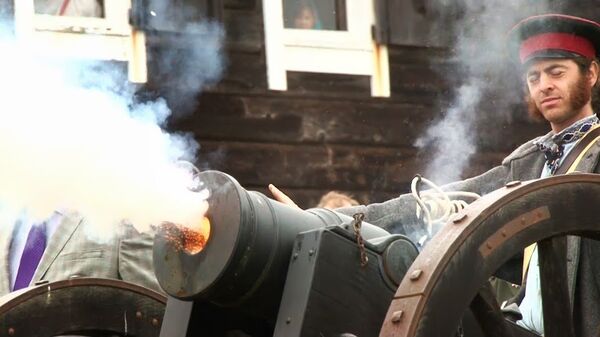FORT ROSS, Calif., July 31 (by Karin Zeitvogel for RIA Novosti) - As the tiny Russian settlement of Fort Ross along California’s Pacific Coast celebrates its 201st anniversary, Americans and Russians taking part in the ceremonies called on the leaders of their respective governments to learn from the Russians and Native Americans living there in the 1800s to improve relations between the two countries.
Russian traders who settled at this idyllic spot and built the wooden stockade and houses that make up Fort Ross lived side by side in harmony with the local Kashaya tribe, Native Americans on whose ancestral lands the settlement was built.
“The Kashaya leader traded the land to the Russians, and the Russians drilled and they found good water and they found good trees here, so they decided to build a fort,” Martina Morgan, a member of the Kashaya tribe who volunteers at Fort Ross, which is now a California state historic park, told RIA Novosti.
In the eyes of the Kashaya, living with Russians was preferable to having the other colonial force in western America, the Spanish, on their ancestral lands, said volunteer Amy Lemmer, who was one of dozens of re-enactors helping celebrate Fort Ross’ birthday this month by wearing period clothes and doing chores the way they were done in the 1800s.

A Kashaya dancer performs in front of Russian ambassador to the United States Sergey Kislyak (center, wearing a black blazer) and Governor of Vologda region Oleg Kuvshinnikov at the Fort Ross Festival in California. (K. Zeitvogel, RIA Novosti)
“The Kashaya were treated well by comparison to what was going on with the Spanish,” Lemmer said as she stirred a beef-and-berry stew that was simmering in a cauldron-like pot over a log fire.
“The Russian Orthodox church didn’t have a policy of forced conversion like they had at the Spanish missions, and by the time the Russians got here, they had policies in place for how to treat the natives: they were paid a salary and the situation was favorable compared to some of the other relationships with Europeans,” she said.

Kashaya girls perform a dance at the 201st anniversary celebrations of Fort Ross in California. (K. Zeitvogel, RIA Novosti)
Within a few years of building the stockade, many of the Russians moved outside its walls to live alongside the Kashaya and Native Alaskans who had come to California with the Russians.
The Russian settlers shared their knowledge of how to use the latest technology at the time with the Native Americans, teaching them to make soap from animal fat and ash, to wash their clothing using a wooden washboard they brought with them from Russia, to make leather and more.
They planted orchards and vegetable gardens, reared cattle, built a windmill, had a bakery.
A visiting French explorer, Auguste Bernard Duhaut-Cilly, is quoted as saying in 1828 that there were around 60 Russians, 80 Native Alaskans and 80 Kashaya at Fort Ross, “all living in relative harmony.”

Re-enactors prepare a meal the same way it would have been done in the 1800s at Fort Ross. (K. Zeitvogel, RIA Novosti)
At a dialogue held this week that was spawned by the harmonious relations between Russians and Native Americans at Fort Ross, Russian and American officials urged their two countries to look to that past and build a future of better understanding between the two former Cold War foes.
Former Russian Consul General in San Francisco and now a member of the Bilateral Presidential Commission that was set up in 2009 to try and improve Russian-American relations, Vladimir Vinokurov, urged Americans and Russians to “find inspiration in our history to search for ways to improve our current relationship.”
“Our shared common history can be a positive factor in relations,” Vinokurov said.
“We’ve had diplomatic relations for 206 years and only a small fraction of them were during the period of the Cold War,” he said.
Oleg Kuvshinnikov, governor of Russia’s Vologda region -- which is where the founder of Fort Ross, Russian merchant Ivan Kuskov, came from -- presented the fort’s exhibit hall with portraits of Kuskov and his wife, and pledged to share artifacts from the settlement that are now in a museum in Vologda.
The tiny wooden stockade and settlement overlooking the Pacific had “tied the destinies of our nations together,” he said.

Suzanne Novotny holds an old Russian-style washing board as she demonstrates how laundry would have been done in the 1800s at Fort Ross. (K. Zeitvogel, RIA Novosti)
And California State Senator Noreen Evans urged Americans and Russians to “reach back to the tolerant, inventive spirit of those who inhabited Fort Ross” as the two countries strive to reset relations.
At the fort, children taking part in the re-enactment rang bells outside the small wooden chapel where the Russians of Fort Ross used to pray. Women spun flax and wool. A young man split a log for the cooks’ fire.
Re-enactor Madison Abbassi wove a basket out of reeds, just as the Kashaya taught the Russians to do in the 1800s. Last year, Abbassi also wove a basket and gave it to her maternal grandmother, who’s Russian.
This year, she said, to be fair and balanced, she planned on giving her memento of Russian-American harmony to her American grandparents on her father’s side.


